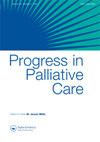澳大利亚专科姑息治疗服务的社区死亡预测因素
IF 0.9
Q4 PUBLIC, ENVIRONMENTAL & OCCUPATIONAL HEALTH
引用次数: 0
摘要
背景:在澳大利亚,人口老龄化加剧了对住宅老年护理设施、医院和临终关怀服务的需求。在南澳大利亚州,癌症患者在家死亡的可能性一直低于14%。目的:本研究旨在调查在澳大利亚社区成人专科姑息治疗服务(SPCS)注册的患者的社区死亡和首选死亡地点的预测因素。方法:对2017年1月1日至6月30日死亡的所有转诊患者进行连续队列回顾性医疗记录和电子数据库回顾。结果:本组共登记死亡456例。排除62例农村患者和32例病历缺失患者。在剩余的362例患者中,62例没有社区面对面接触,被排除在外。300例符合条件的患者中,女性143例,平均年龄71岁。这项研究显示整体社区死亡率(私人安老院及安老院舍)为31.3%,而私人安老院的死亡率为17%。社区死亡有两个重要的预测因素。首先,家庭/照顾者偏好的死亡地点对社区死亡可能性的影响远大于患者偏好的死亡地点。其次,整个姑息治疗团队的投入强度,特别是社区面对面访问,更具体地说是护士的投入,是主要的预测因素。结论:投资社区spcs不仅可以更好地支持患者和家属/照顾者的偏好,而且可以提高社区死亡率,还可以降低住院费用。本文章由计算机程序翻译,如有差异,请以英文原文为准。
Predictors of community death in an Australian specialist palliative care service
Background: In Australia, an aging population has intensified demand on residential aged care facilities, hospitals and palliative care services for end-of-life care. The likelihood of home death for cancer patients in South Australia has remained below 14%. Objectives: This research aims to investigate predictors for community death and preferred place of death of patients registered with an Australian community adult specialist palliative care service (SPCS). Methods: A consecutive cohort retrospective medical records and electronic database review of all referred patients who died between 1st January and 30th June 2017 was undertaken. Results: There were 456 registered patients who died in this period. The 62 rural patients and 32 patients with missing medical records were excluded. Of the remaining 362 patients, 62 did not have community face-to-face contact and were excluded. Of the 300 patients eligible, there were 143 females and mean age was 71 years. This study revealed an overall community death rate (private home and residential aged care facility) of 31.3% compared with private home death rate of 17%. There were two important predictors of community death. Firstly, family/caregiver preferred place of death had a far greater impact on likelihood of community death than patient preferred place of death. Secondly, the intensity of input from the whole palliative care team, in particular, community face-to-face visits and more specifically by nurses, were major predictors. Conclusion: Investing in community-based SPCSs may not only better support patient and family/caregiver preferences, and increase rates of community death but also reduces hospitalisation costs.
求助全文
通过发布文献求助,成功后即可免费获取论文全文。
去求助
来源期刊

PROGRESS IN PALLIATIVE CARE
PUBLIC, ENVIRONMENTAL & OCCUPATIONAL HEALTH-
CiteScore
2.60
自引率
11.80%
发文量
24
期刊介绍:
Progress in Palliative Care is a peer reviewed, multidisciplinary journal with an international perspective. It provides a central point of reference for all members of the palliative care community: medical consultants, nurses, hospital support teams, home care teams, hospice directors and administrators, pain centre staff, social workers, chaplains, counsellors, information staff, paramedical staff and self-help groups. The emphasis of the journal is on the rapid exchange of information amongst those working in palliative care. Progress in Palliative Care embraces all aspects of the management of the problems of end-stage disease.
 求助内容:
求助内容: 应助结果提醒方式:
应助结果提醒方式:


